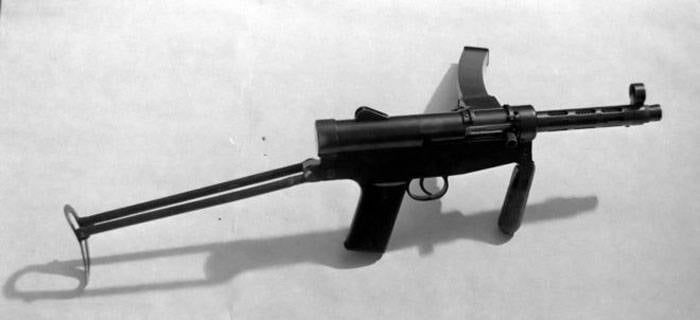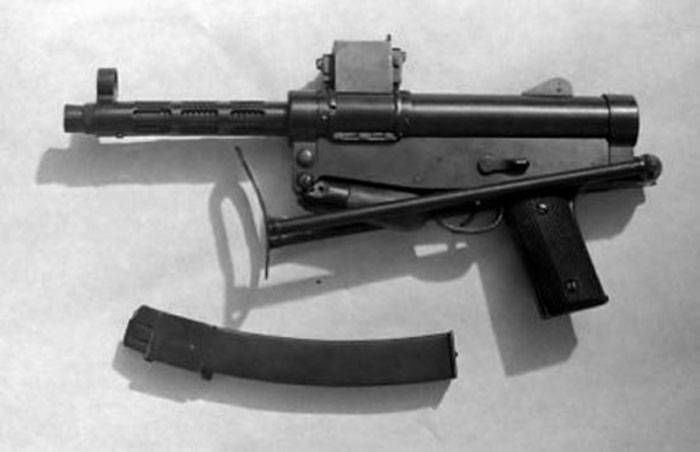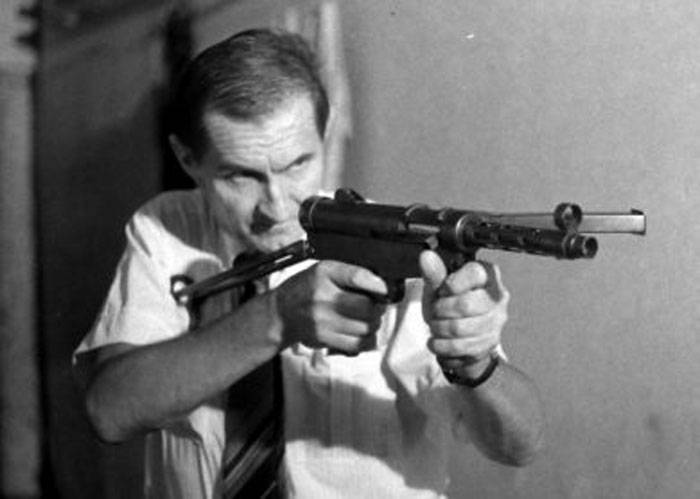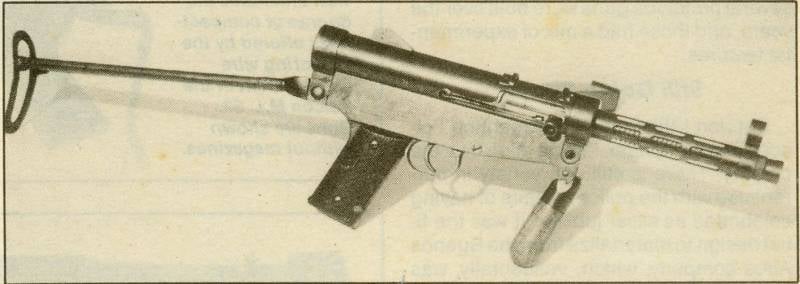The first is Argentine. Submachine gun Juan Lenar
One of the participants in the development of promising weapons was the designer Juan Lenard. By the early thirties, he managed to gain some experience in the development and production of small arms. In addition, the engineer carefully studied the available materials for various foreign samples. In the early thirties, H. Lenard decided to use all available knowledge and all the experience gained in creating the next project. This time, he planned to create the first Argentine submachine gun.

Submachine gun X. Lenar in a combat position
Looking ahead, it should be noted that the first draft of an Argentine-developed submachine gun stopped at the testing stage of an experienced weapon. The finished model was not adopted and, as a result, did not receive an official designation, retaining one of the working names. Currently, this product is known under the name derived from the name of its developer, Lehnar or Subametralladora Lehnar (“Lenar Submachine Gun”).
Having an idea of foreign developments in the field of submachine guns, H. Lenar was able to form the optimal look of the new weapons of this class. From the point of view of the main ideas and decisions, his project had to resemble the existing developments in the most serious way. At the same time, there were some differences of one kind or another. The latter, in the first place, were associated with the use of new devices and parts. In addition, the designer did not intentionally simplify the design of the submachine gun, which made it possible to obtain a product that is quite easy to use.
With a good performance and neat finish, an experienced Lenar submachine gun was not distinguished by the complexity of design and manufacturing. Most of the parts of the weapon was supposed to be stamped. Other technologies were used only in the manufacture of a few parts where the use of stamps was by definition impossible. A number of one-piece joints of the units were made by welding.
From the point of view of the overall layout of the submachine gun X. Lenar was a typical representative of his class, created in the interwar period. The weapon was supposed to use the Parabellum 9x19 pistol cartridge. It was planned to equip the trunk of medium length, placed inside the protective casing. Simple automatics based on the free gate mounted inside the tubular receiver. Like some foreign products, the new Lehnar was supposed to have a side feed of cartridges. Also provided for the use of folding stock.
The project used a rifled barrel caliber 9 mm length of the order of 22-25 calibers. Almost all the outer surface of the trunk was provided with fins, which improved cooling with atmospheric air. The barrel was inside a tubular metal casing with several rows of longitudinal oval holes. In front of the casing there was a small conical flame arrester. Over him was a fly. The barrel together with the casing were fixed on the front cut of the receiver.
All the main parts of the weapon were placed inside a pair of shells that assembled a receiver box. To install the bolt and the recoil-fighting spring was intended upper cylindrical casing of sufficient length. In its front part, behind the mountings of the trunk, two windows were provided. The left was intended for the filing of cartridges, the right - for the release of spent cartridges. In front of the side windows and behind them, the box was covered with two rings, with the help of which it was proposed to install a store receiving device. From the bottom of the ejection window of the sleeves, there was a longitudinal slot of a medium length, which was necessary for the withdrawal of the bolt handle. Behind the tube was closed with a lid, combined with a clamp for connection with the bottom of the receiver.
Below to the tubular device with a few clamps joined polygonal unit. The front part of this device with a beveled bottom edge served as a support for an additional handle, while the rear part contained parts of a firing mechanism. A pistol grip and a butt hinge were also placed there.
Juan Lenar used the simplest automation characteristic of submachine guns — the weapon used the principle of the free shutter. The shutter was made in the form of a massive unit with a close to round cross section. The shutter had a set of cavities and channels to accommodate some devices. On its left side was attached cocking handle. Behind him propped a large return-combat spring. A separate drummer was not provided. As far as is known, this detail has been integrated into the shutter mirror. The fire was fired from the open bolt. Before the shot, the bolt was retracted to the extreme rear position and was fixed in it in a sear.
Mastering a new direction for themselves, the Argentine gunsmith was not afraid to use a relatively complex trigger mechanism, which provided shooting in different modes. Shooting was carried out using a traditional kind of trigger, covered with a protective bracket. The choice of fire mode or blocking was carried out using the movable flag on the left side of the USM casing. The axis of the flag was located near the axis of the trigger. The box itself was turned back in all positions.
In the extreme upper position, at the “TIRO” label, the checkbox allowed shooting single. The middle position of “AUTO” provided automatic fire. Being shifted down in the “SEG” position, he blocked the firing mechanism and made the weapon safe.
Submachine gun Lehnar received not the most difficult, but quite interesting ammunition system. Cartridges type 9x19 mm "Parabellum" should have been stored and supplied from the detachable sector stores with a slight bend of the body. In this case, the store was located horizontally, and the supply of cartridges was carried out on the left. Through the right window automatics threw empty cartridges.
To install the store it was proposed to use a device of a curious construction. On the receiver, between a pair of outer rings, a movable receiver was placed. It consisted of two main parts: an open tube with a large gap and a rectangular receiver with a latch. In the working position, the receiver was placed horizontally to the left of the receiver. A large section of the tube coincided with the ejection window of the sleeves.
When transferring the weapon to the stowed position, the receiver was proposed to rotate 90 ° clockwise (relative to the arrow). As a result, the receiving shaft was on top, and its clearance coincided with the top of the receiver. The receiver tube, in turn, blocked the windows for the supply of cartridges and ejection of liners. In this position, the receiver protected the receiver from dirt through the largest holes.
The submachine gun received the simplest sights. In front of the barrel casing there was a front sight in an annular earpiece. The open sight was located near the rear of the receiver. Reversible rear sight allowed to fire at a distance 100 or 200 m. The side walls of the sight protected him from external influences.
In his project, H. Lenar took care of the convenience of the shooter, and the submachine gun received a pair of handles for proper retention when firing. In the back of the receiver was a pistol grip with wooden lining. In front of her was the trigger bracket. In front of the lower unit of the receiver was a hinge for installing an additional vertical handle. The applied means of installation allowed to put this handle under the receiver.

View from the left, the fire translator is clearly visible.
The weapon was also equipped with a folding butt, externally resembling the aggregates of some foreign models. Butt consisted of two thin rods or tubes of long length and shoulder rest in the form of a curved metal oval. Butt mounted on a hinge at the rear of the receiver. To reduce the size of the weapon, it was proposed to fold the stock down and forward. In this case, the shoulder rest reached the lower surface of the barrel casing, and the longitudinal rods were at a certain angle to the longitudinal axis of the weapon.
The total length of the Lehnar submachine gun was 700 mm. When the stock is folded, the length is reduced to 410 mm. Some sources indicate the length of the folded arms at the level of 210 mm, but it is obvious that this is a simple mistake. Information about the mass of weapons available. It can be assumed that the prototype weighed no more than 3,5-4 kg.
According to known data, the submachine gun Juan Lenar on tests showed a rate of fire at the level of 550 rounds per minute. The “Parabellum” cartridge allowed attacking targets at ranges up to several hundred meters with an effective distance of no more than 100-150. It is easy to see that the firing characteristics of a Lehnar submachine gun were at the level of other samples of this class that existed in the early thirties.
It is known that the designer H. Lenar completed the development of his project in the early thirties. Soon at one of the Argentine weapons companies produced the first prototype of a submachine gun. As it became clear later, the first prototype was also the last. The prototype, apparently, was tested in a shooting range and, possibly, offered to a potential customer in the person of the army of Argentina.
According to all known sources, the armed forces and the police showed no interest in the proposed weapon. The reasons for the refusal of the first domestic submachine gun unknown. Perhaps the potential customer did not see the point in the weapons of the new class. In addition, we can not exclude the possibility of rejection of the product due to the presence of certain shortcomings. Another explanation of such events may affect the limited financial capabilities of the army or the impossibility of mass production of weapons by existing industry.

Submachine gun Lehnar in the hands of Pantaleon Kotelchuk, the beginning of the 90's
Anyway, the submachine gun X. Lenara was not adopted by Argentina and did not enter the series. Orders from third countries have not been received. New weapons left without real prospects. The designer was forced to abandon the continuation of work on an existing project. Subsequently, he participated in the creation of several new Argentine small arms.
No longer needed prototype "Lenara" went to storage. It was quickly forgotten and actually lost. For several decades, the weapon remained unknown until it was discovered at one of the Argentine warehouses. The unique model, which became the predecessor of a number of other projects of small arms, returned from non-existence and received deserved fame. The forgotten submachine gun was discovered by the gunsmith of the organization Registro Nacional de Armas (RENAR) Pantaleon Kotelchuk. The historian Ronaldo Oliva helped spread information about an unknown sample.
As far as is known, at the beginning of the nineties, the only made submachine gun X. Lenar was in one of the offices of RENAR. Information about his fate is absent. There is reason to believe that he remained in the warehouse of the state organization, where he remains to this day. At least, news on the transfer of a unique product to a museum or on its sale at auction in recent decades have not appeared.
Having received the refusal of potential operators, H. Lenard stopped work on his first submachine gun. These events are not the best way affected the development of advanced weapons. Over the next few years, Argentine engineers did not return to the subject of submachine guns. A new project of this kind appeared only in the mid-thirties. It is noteworthy that this time it was a whole family of three submachine guns with a high degree of unification. Two new models of the three were adopted and produced a relatively large series.
Juan Lenar was the first of the Argentine gunsmiths to undertake the design of a submachine gun and first presented a ready-made sample of such weapons. For certain reasons, his project has not advanced beyond the assembly and testing of the prototype. The army and police did not want to buy such weapons, and the project was left without a future. Subsequently, the most interesting sample was forgotten for several decades. However, even with this result, the Lehnar submachine gun was able to return from non-existence and take its rightful place in stories, remaining the first model of its class, created in Argentina and throughout South America.
On the materials of the sites:
http://forgottenweapons.com/
http://thefirearmblog.com/
http://modernfirearms.net/
https://fieldjournals.com/


Information